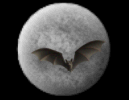
Blackholes2 Forum Message | |
| Forums: |
Atm ·
Astrophotography ·
Blackholes ·
Blackholes2 ·
CCD ·
Celestron ·
Domes ·
Education
Eyepieces · Meade · Misc. · God and Science · SETI · Software · UFO · XEphem |

 |
|
 |
||||
|
|
||||||
Be the first pioneers to continue the Astronomy Discussions at our new Astronomy meeting place... The Space and Astronomy Agora |
| Re: Black Hole Questions - NEED AN EXPERT . . .
Forum List | Follow Ups | Post Message | Back to Thread Topics | In Response To Posted by Paul Rest/">Paul Rest on September 18, 1998 05:07:57 UTC |
|
I can't answer your first question, perhaps someone else can, but I'll answer the other two. On you second question: I believe you are referring to the phenomenon of your local time slowing down as you fall towards a singularity (if such a thing can exist), giving the impression of time beyond the blackhole speeding up. Supposedly just before you cross the event horizion you would see time outside the black hole's influence move infinitly fast, so you would see the end of the universe. In order to "hover" just above a black hole's event horizion you would need an amount of convential thrust nearly equal to the amount necessary to accelerate to the speed of light, which would be very hard but theoretically possible. Things like warp drives and wormholes and other such hyperspace and indirect drives wouldn't work in such a situation. So yes you could do it, but it would take an unimagiable amount of energy. To your third question: the nearest blackhole is a X-ray source designated Cygnus X-1, in the constellation Cygnus (the Swan). In this case we have a star orbiting a very massive companion which we can't see in visual wavelengths but is very bright in X-rays. A black hole has an accretion disk around it, material falling in towards the center. This material as it spins and is compacted together emmits a particular type of X-rays (or so our theories tell us) which is the same type of X-rays coming from Cygnus X-1. The unseen companion to the star and the X-rays point to a black hole, plain and simple. We aren't absolutely positive, but we're pretty sure about it. Yes there is a supermassive back hole at the center of our galaxy, something like several hundred million times the mass of our sun. There are actually black holes at the centers of many galaxies, M31, M87, and in the case of M87 we've actually photographed a huge jet of material being ejected out by this black hole into space. Black holes at the center of galaxies are actually what are responsible for quasars, huge jets of plasma being shot out at what is sometimes very close to the speed of light. I should say that I am not an expert by any means, merely an amateur astronomer who reads to much and thinks to much. So don't go citing me in your report as straight from the source. Other things I can suggest you look up for your report are Hawking Radiation and spinning singularities, both are very interesting topics. -Paul : Hi, I was wondering if someone could answer a few questions on black holes. I'm doing a report at school, and I need some questions answered by "experts." So if anyone out there is an expert, please answer these questions, and include your name, occupation, where you work, and all that type of stuff.Okay: : 1) What is the probability that in the future, time travel through white holes will be possible? : 2) Is it possible to see the fate of the universe by charging your thrusters while in a black hole so that you aren't sucked in? : 3) Where are the nearest black holes? IS there a black hole in the middle of our galaxy. : Thanks for all the help. : : Numair Faraz
|
|
|
| Additional Information |
|---|
| About Astronomy Net | Advertise on Astronomy Net | Contact & Comments | Privacy Policy |
|
Unless otherwise specified, web site content Copyright 1994-2025 John Huggins All Rights Reserved Forum posts are Copyright their authors as specified in the heading above the post. "dbHTML," "AstroGuide," "ASTRONOMY.NET" & "VA.NET" are trademarks of John Huggins |